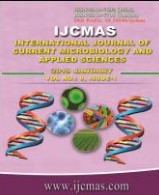


 National Academy of Agricultural Sciences (NAAS)
National Academy of Agricultural Sciences (NAAS)

|
PRINT ISSN : 2319-7692
Online ISSN : 2319-7706 Issues : 12 per year Publisher : Excellent Publishers Email : editorijcmas@gmail.com / submit@ijcmas.com Editor-in-chief: Dr.M.Prakash Index Copernicus ICV 2018: 95.39 NAAS RATING 2020: 5.38 |
Diabetic foot is one of the most feared complications of diabetes and is the leading cause of hospitalization in diabetic patients. Diabetic patients have a lifetime risk as high as 25% for developing into foot ulceration. The reasons for the increased incidence of diabetic ulcer involve the interaction of several pathogenic factors like neuropathy, abnormal foot biomechanics and peripheral arterial disease. The study was performed to determine the microbial etiology (aerobic and anaerobic) of diabetic foot ulcer and their susceptibility pattern in a tertiary care hospital. A total number of 120 diabetic patients were studied over a period of two year. Pus and tissue samples were collected for bacteriological study. The specimens were processed in the Microbiology laboratory for Gram stain, aerobic culture, and anaerobic culture. The organisms isolated were identified by standard procedures and antimicrobial susceptibility was done by Kirby-Bauer disc diffusion method. Out of 120 samples, a total of 227 organisms were isolated in the present study, with an average of 1.87 organisms per specimen. Among them, aerobic organisms were 166 (73.1%) and anaerobic organisms were 61 (26.9%). Out of 166 aerobic organisms isolated, the most common isolates were Pseudomonas aeruginosa 41(24.70%) followed by Staphylococcus aureus 33(19.88%). Amongst 61(26.9%) anaerobes, Peptostreptococcus magnus (27.8%) was the commonest isolated organism. Aerobes were found to be susceptible mainly to antibiotics like Vancomycin, Imipenem, Piperacillin - Tazobactum while anaerobes were susceptible to Metronidazole. Pseudomonas aeruginosa was predominant isolate in aerobes while Peptostreptococcus magnus was commonest among anaerobe. This study will help the clinician for proper management of ulcer and thus reduces dreaded complication of it.
 |
 |
 |
 |
 |